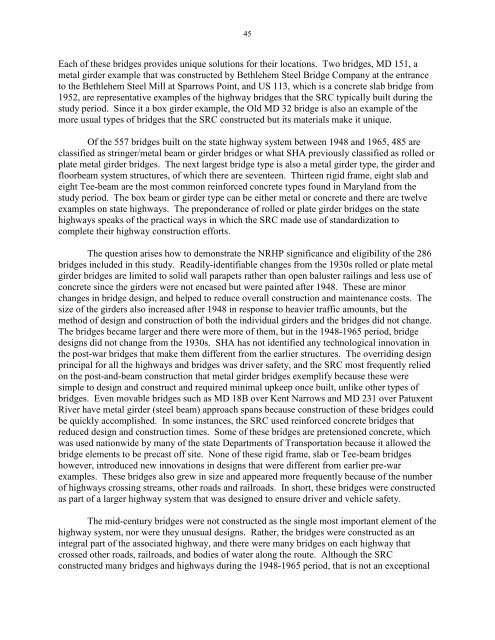TOMORROW'S ROADS TODAY - Maryland State Highway ...
TOMORROW'S ROADS TODAY - Maryland State Highway ...
TOMORROW'S ROADS TODAY - Maryland State Highway ...
You also want an ePaper? Increase the reach of your titles
YUMPU automatically turns print PDFs into web optimized ePapers that Google loves.
45<br />
Each of these bridges provides unique solutions for their locations. Two bridges, MD 151, a<br />
metal girder example that was constructed by Bethlehem Steel Bridge Company at the entrance<br />
to the Bethlehem Steel Mill at Sparrows Point, and US 113, which is a concrete slab bridge from<br />
1952, are representative examples of the highway bridges that the SRC typically built during the<br />
study period. Since it a box girder example, the Old MD 32 bridge is also an example of the<br />
more usual types of bridges that the SRC constructed but its materials make it unique.<br />
Of the 557 bridges built on the state highway system between 1948 and 1965, 485 are<br />
classified as stringer/metal beam or girder bridges or what SHA previously classified as rolled or<br />
plate metal girder bridges. The next largest bridge type is also a metal girder type, the girder and<br />
floorbeam system structures, of which there are seventeen. Thirteen rigid frame, eight slab and<br />
eight Tee-beam are the most common reinforced concrete types found in <strong>Maryland</strong> from the<br />
study period. The box beam or girder type can be either metal or concrete and there are twelve<br />
examples on state highways. The preponderance of rolled or plate girder bridges on the state<br />
highways speaks of the practical ways in which the SRC made use of standardization to<br />
complete their highway construction efforts.<br />
The question arises how to demonstrate the NRHP significance and eligibility of the 286<br />
bridges included in this study. Readily-identifiable changes from the 1930s rolled or plate metal<br />
girder bridges are limited to solid wall parapets rather than open baluster railings and less use of<br />
concrete since the girders were not encased but were painted after 1948. These are minor<br />
changes in bridge design, and helped to reduce overall construction and maintenance costs. The<br />
size of the girders also increased after 1948 in response to heavier traffic amounts, but the<br />
method of design and construction of both the individual girders and the bridges did not change.<br />
The bridges became larger and there were more of them, but in the 1948-1965 period, bridge<br />
designs did not change from the 1930s. SHA has not identified any technological innovation in<br />
the post-war bridges that make them different from the earlier structures. The overriding design<br />
principal for all the highways and bridges was driver safety, and the SRC most frequently relied<br />
on the post-and-beam construction that metal girder bridges exemplify because these were<br />
simple to design and construct and required minimal upkeep once built, unlike other types of<br />
bridges. Even movable bridges such as MD 18B over Kent Narrows and MD 231 over Patuxent<br />
River have metal girder (steel beam) approach spans because construction of these bridges could<br />
be quickly accomplished. In some instances, the SRC used reinforced concrete bridges that<br />
reduced design and construction times. Some of these bridges are pretensioned concrete, which<br />
was used nationwide by many of the state Departments of Transportation because it allowed the<br />
bridge elements to be precast off site. None of these rigid frame, slab or Tee-beam bridges<br />
however, introduced new innovations in designs that were different from earlier pre-war<br />
examples. These bridges also grew in size and appeared more frequently because of the number<br />
of highways crossing streams, other roads and railroads. In short, these bridges were constructed<br />
as part of a larger highway system that was designed to ensure driver and vehicle safety.<br />
The mid-century bridges were not constructed as the single most important element of the<br />
highway system, nor were they unusual designs. Rather, the bridges were constructed as an<br />
integral part of the associated highway, and there were many bridges on each highway that<br />
crossed other roads, railroads, and bodies of water along the route. Although the SRC<br />
constructed many bridges and highways during the 1948-1965 period, that is not an exceptional
















